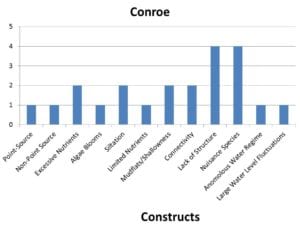Lake Conroe has suffered more than its share of ups and downs over the years—pun intended. The lake north of Houston has been plagued with infestations of exotic vegetation, damage to native vegetation by an overpopulation of grass carp introduced to get rid of the exotic vegetation, a degraded watershed, lack of shoreline habitat for fish and dissension over what to do about all the problems.
Typical of many aging reservoirs, Conroe is impaired by nuisance species, in this case Hydrilla, and lack of structure. Other notable impairments include factors associated with sedimentation and development such as excessive nutrients, mudflats/shallowness and loss of connectivity.
Key to addressing these threats is an informed public. Public outreach associated with the Conroe native vegetation project is raising awareness of the environmental/ecological threats facing Lake Conroe. Cooperative action among shoreline property owners and all other users of Lake Conroe is the only way to ensure the long-term ecological health of the system.
